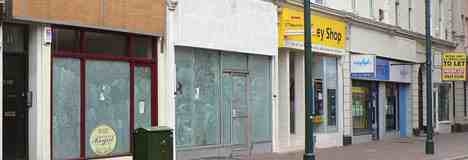BOOTLE made the top 10 charts today – for its high number of empty shops, with Runcorn old town joining it for a top spot.
Figures release by the Local Data Company paint a bleak picture of shopping streets in the North West compared to London and the better-off South East.
Bootle was in 5th place with a shop vacancy level of 27 percent, followed in sixth spot by Church Street – the main shopping street in Runcorn old town, with a 26.8 percent vacancy rate in the survey.
Morecambe topped the chart with a vacancy level of 32.9 percent, with Highgate in London earning top place for the lowest number of empty shops – not a single vacancy in their high street.
 Church Street RuncornThe North West captured five of the top spots, giving the region the highest level of empty shops – 17.3 percent - five percent higher than the national average of 12 percent. Across Greater London, the number of shops standing empty was 8 percent - less than half the level in the North West.
Church Street RuncornThe North West captured five of the top spots, giving the region the highest level of empty shops – 17.3 percent - five percent higher than the national average of 12 percent. Across Greater London, the number of shops standing empty was 8 percent - less than half the level in the North West.
Local Data Company Director Matthew Hopkinson warned of some shopping streets disappearing, adding with 50,000 empty shops across the country there are simply far too many retail shops.
He said: “What is clear from our latest report on vacancy rates, ‘Divide and Rule’, is that there is a significant and growing divide between the north of the country and the south. In addition, we are seeing greater concentration of the best retail and leisure destinations in fewer centres, be they large out of town ‘shopping parks’ or the increasing number of ‘mega malls’ of which Trinity Leeds was the latest example to open in 2013.
“Of these ‘all inclusive’ destinations there are now approximately 25 where the consumer gets all of the experiences, offer and variety that they demand. So what of the hundreds of towns that sit in the shadow of these places?
“The data shows the best and the worst in vacancy rates but 2013 clearly showed that physical stores have a key role to play in engaging with your customers. The meteoric rise in ‘click & collect’ is but one example of the importance of the relationship between ‘bricks and clicks’ along with the increasing significance of convenience shopping.
“The historical analysis of vacancy rates shows not all places can or will be able to adjust to the 21stCentury ‘High Street’. It requires consumer spend, retailer commitment, landlord investment and a long term structural commitment by Government. As with any successful strategy there needs to be a plan which is evidence based, realistic, measurable and most importantly matches the needs, aspirations and economic reality of consumers, occupiers and landlords. Without this there will be no meaningful change and the communities that we all like to speak of will disappear but not without wider social consequences.
It is clear that Great Britain has too many shops, over 50,000 lie empty, and that technology will drive further consolidation. The speed of change is quickening and it is therefore more important than ever before to know which locations are thriving, surviving or dying.”
The data shows the increasing impact of large shopping centres and retail parks and their dominance of the retail landscape. Analysis of the 12 biggest shopping centres found most of the surrounding weaker towns and High Streets continue to decline, raising questions over their future direction and viability.
The Local Data Company monitors more than 2,000 town and shopping centres and retail parks, with its surveys acting as a barometer of activity on Britain’s high streets. It's report costs £250 plus VAT.















